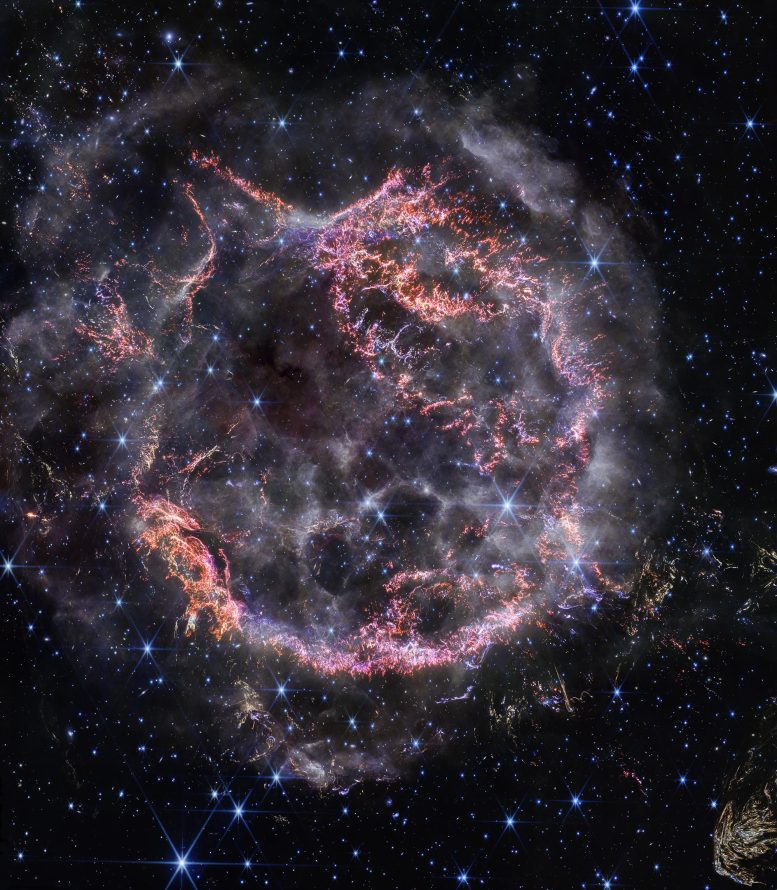
A new high-definition image from NASA’s James Webb Space Telescope’s NIRCam (Near-Infrared Camera) unveils intricate details of supernova remnant Cassiopeia A (Cas A), and shows the expanding shell of material slamming into the gas shed by the star before it exploded. Credit: NASA, ESA, CSA, STScI, Danny Milisavljevic (Purdue University), Ilse De Looze (UGent), Tea Temim (Princeton University)
NASA’s Webb Space Telescope’s new look at an exploded star…
Teams prepare to install some Moon rocket hardware…
And completing NASA’s first two-way, end-to-end laser relay system…
A few of the stories to tell you about – This Week at NASA!
This Week @NASA: Webb’s New Look at Exploded Star, Space Station Laser Link & Europa Clipper
Webb’s New High-Definition Look at an Exploded Star
NASA’s James Webb Space Telescope recently captured this new image of supernova remnant Cassiopeia A. The image, captured by Webb’s Near-Infrared Camera, displays the stellar explosion at a resolution previously unreachable at these wavelengths, and is giving astronomers hints at the dynamic processes occurring within the supernova remnant.
NASA’s Artemis II mission is advancing with the final preparations of the SLS rocket at Kennedy Space Center. The Orion stage adapter, a key component connecting Orion to the SLS, recently underwent a critical installation of its diaphragm at Marshall Space Flight Center. This adapter plays a vital role in ensuring safety during launch by preventing hydrogen gas accumulation. Credit: NASA/Sam Lott
Teams Prepare Moon Rocket to Spacecraft Connector for Assembly
Teams at NASA’s Marshall Space Flight Center recently flipped the Orion stage adapter to prepare the adapter for the installation of its diaphragm.
The stage adapter connects the Orion spacecraft to the Space Launch System rocket’s interim cryogenic propulsion stage, or ICPS. The diaphragm helps prevent highly flammable hydrogen gas, that could escape the rocket’s propellant tanks, from building up beneath Orion and its crew before and during launch.
NASA’s ILLUMA-T payload communicating with LCRD over laser signals. Credit: NASA/Dave Ryan
Space Station Laser Communications Terminal Achieves First Link
NASA’s LCRD and the new space station technology experiment, ILLUMA-T, successfully exchanged data for the first time — marking ILLUMA-T’s first laser link with an in-orbit laser relay system. Together, LCRD and ILLUMA-T completed NASA’s first two-way, end-to-end laser relay system.
Laser communications uses infrared light rather than traditional radio waves to send and receive signals, which allows spacecraft to pack more data into each transmission.
The “Message in a Bottle” campaign offers everyone the opportunity to have their name stenciled onto a microchip bearing U.S. Poet Laureate Ada Limón’s “In Praise of Mystery: A Poem for Europa.” The chip will ride aboard NASA’s Europa Clipper spacecraft to Jupiter and its moon Europa. Credit: NASA
Add Your Name To Fly on Europa Clipper Mission
The deadline to join NASA’s Europa Clipper mission’s “Message in a Bottle” campaign is 11:59 p.m. EST, December 31, 2023. You can join the mission and have your name engraved on our Europa Clipper spacecraft, which will travel 1.8 billion miles to explore Jupiter’s icy moon, Europa.
Learn more at go.nasa.gov/MessageInABottle.
That’s what’s up this week @NASA!
>>> Read full article>>>
Copyright for syndicated content belongs to the linked Source : SciTechDaily – https://scitechdaily.com/this-week-nasa-webbs-new-look-at-exploded-star-space-station-laser-link-europa-clipper/